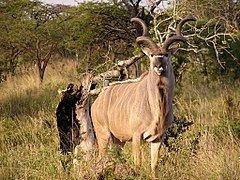Kingdom Animalia Order Artiodactyla Subfamily Bovinae Gestation period Greater kudu: 240 days Speed Lesser kudu: 70 km/h | Phylum Chordata Family Bovidae Height Lesser kudu: 90 – 110 cm Higher classification Bovinae Rank Tribe | |
 | ||
Mass Lesser kudu: 60 – 90 kg, Greater kudu: 190 – 270 kg Lower classifications Spiral‑horned bovines, Nyala, Bongo, Lesser kudu, Greater kudu | ||
Where the Boselaphini and Bovini are mostly Asian, members of the Tragelaphini tribe, the spiral-horned antelopes, are found only on the continent of Africa. This group tends to large size, a lighter build, longer necks and considerable sexual dimorphism. Eight of the 10 species are of conservation concern, being classified as lower-risk, conservation dependent, the remaining two, the Common Eland and the Giant Eland are secure.
The above is considered the traditional taxonomy for the spiral-horned antelope group, but recently the relationships between the various species has changed somewhat. The Lesser Kudu is now considered the most basal member of the group followed by the Nyala, then the Greater Kudu, both species of Eland, and all other groups of Spiral-Horned Antelope group together. This has led to a change in taxonomy for several of the members of the group. Assuming that the Elands (Taurotragus) are a separate genus, which most biologists seem to agree on, then all the more basal members of the group are deserving of their own genus. What was considered two genera is now considered five.
Further, many of these new genera might have multiple species (i.e. Ammelaphus imberbis and Ammelaphus australis). [1] [2]
1. The Evolution of Artiodactyls by Donald R. Prothero and Scott E. Foss 2. Ungulate Taxonomy by Peter Grubb and Colin Groves
